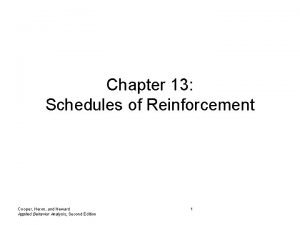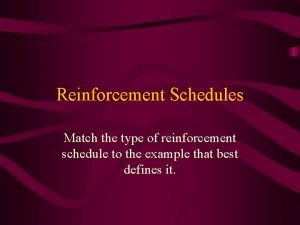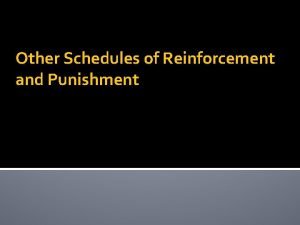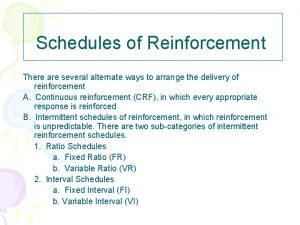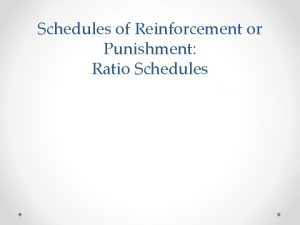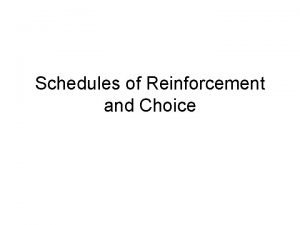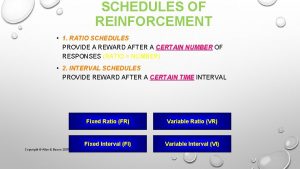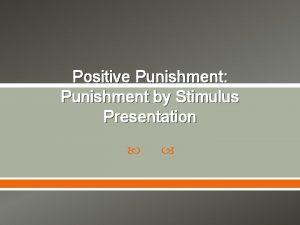Schedules of Reinforcement or Punishment Interval Schedules Ratio












- Slides: 12

Schedules of Reinforcement or Punishment: Interval Schedules

Ratio Schedules �Focus on the number of responses required before reinforcement is given

Interval Schedules �Specific amount of time elapses before a single response produces reinforcement or punishment �Two issues: �A specific time period must pass before reinforcement or punishment can become available �Reinforcement is contingent on the first response that occurs during the required time period

Fixed Interval (FI) Schedules �Fixed Interval (FI) �Provides reinforcement for the first correct response following a fixed period of time. �Elapse of time alone is not sufficient for reinforcer delivery. �Example: �Fixed Interval 2 min (FI 2) – Reinforcement is delivered for the first response after the 2 minutes have elapsed.

Characteristics �Tend to produce a slow to moderate of responding �Typically produces a postreinforcement pause �Generally, the larger the fixed interval requirement, the longer the postreinforcement pause �Usually see accelerating rate of response toward the end of the interval �Called an FI scallop

Fixed Interval (FI) Schedule Effects. A = Postreinforcement pause B = increase in response rates as interval progresses and reinforcer becomes available Responses B C = reinforcer delivered contingent on first correct responses after interval A Schedule Effects: C Time FI schedules generate slow to moderates of responding with a pause in responding following reinforcement. Responding begins to accelerate toward the end of the interval.

Variable Interval (VI) Schedules �Provides reinforcement for the first correct response following a variable amount of time when reinforcement can become available �“Average” amount of time �Variable Interval - 3 minute schedule. Reinforcement becomes available on an average every three minutes. Reinforcement occurs after the first response during the interval

Characteristics �Tends to produce low to moderate of response. �Tends to produce a constant, stable rate of response. �Typically produces few hesitations between responses. �The larger the average interval, the lower the overall rate of response

Basic Schedules of Reinforcement �Variable Interval (VI) Schedule Effects A = Steady response rate; few, if any, postreinforcement pauses Responses B = Reinforcer delivered A Schedule Effects: B Time A VI schedule generates a slow to moderate response that is constant and stable. There are few, if any, postreinforcement pauses with VI schedules

Points to Note About Interval Schedules �In general, the longer the schedule the lower the rate of responding �FI-1 minute vs. FI-10 minute schedule �Need to begin with FI- 1 and gradually thin the schedule. �Want to keep the schedule short �May not be the best choice to keep kids on task �Alternative – Use a Limited Hold (LH) �Participants must respond within a brief period of time when the interval begins

Thinning �Gradually increasing the amount of time between availability of reinforcers �Can provide instructions such as rules, directions or prompts to communicate the schedule of reinforcement.

Conclusions �Interval schedules provide lower rates of responding than ratio schedules �Variable schedules provide good resistance to extinction �Can be combined with other schedules
 Variable interval positive reinforcement
Variable interval positive reinforcement Schedules of reinforcement
Schedules of reinforcement Types of reinforcement schedules
Types of reinforcement schedules Skinner reinforcement schedule
Skinner reinforcement schedule Acquiring experience
Acquiring experience Continuous reinforcement
Continuous reinforcement Instinctive drift psychology definition
Instinctive drift psychology definition Types of reinforcement schedules
Types of reinforcement schedules Classical vs operant conditioning
Classical vs operant conditioning Reinforcement schedule types
Reinforcement schedule types Compound schedules of reinforcement examples
Compound schedules of reinforcement examples Fixed ratio schedule example
Fixed ratio schedule example Intermittent schedule of reinforcement
Intermittent schedule of reinforcement

